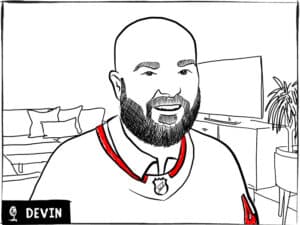Webinar: Lead Generation Part 1 – Outbound Lead Gen
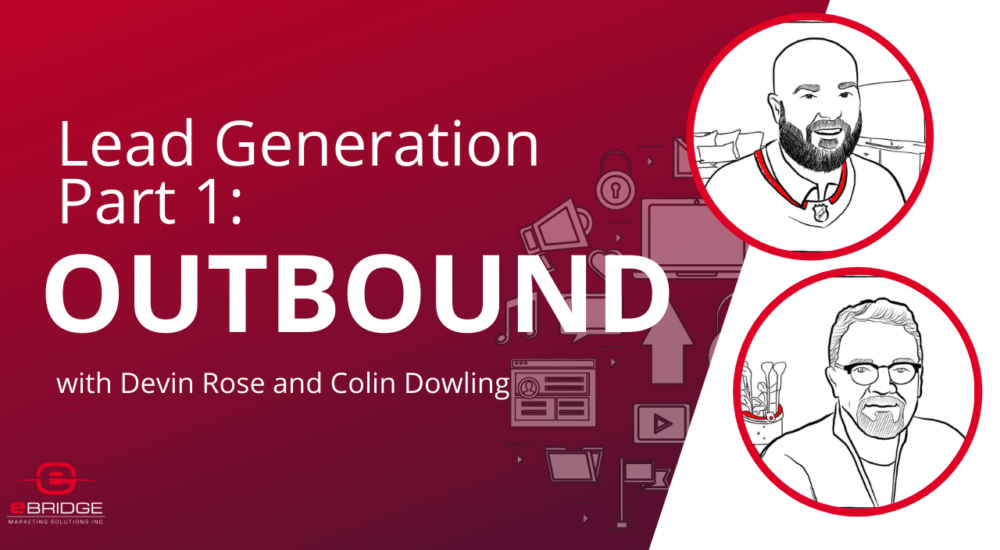
Many readers will be aware that The Host Broker is operated alongside eBridge Marketing Solutions, our marketing arm. eBridge is a digital marketing agency created just for IT Service Providers. Recently eBridge’s Devin Rose and Colin Dowling presented a 30 minute webinar to answer both common and esoteric questions about outbound lead generation for IT Service Providers. Check out the video and transcript below!
Watch Webinar
Webinar Transcription
Please excuse transcription errors.
Devin: Thanks everyone for joining today. I’m so happy to have our own Colin Dowling from eBridge Marketing Solutions to join us for our second presentation – Outbound Lead Generation Part 1. Sorry, our first part on lead generation. We have another part planned in a couple of weeks, so keep your eyes peeled if you are interested in this topic. The subsequent one will be featuring myself, Devin Rose only. And today’s presentation is brought to you by both The Host Broker and eBridge Marketing Solutions. So, let me tell you a little bit about both these companies.
The Host Broker
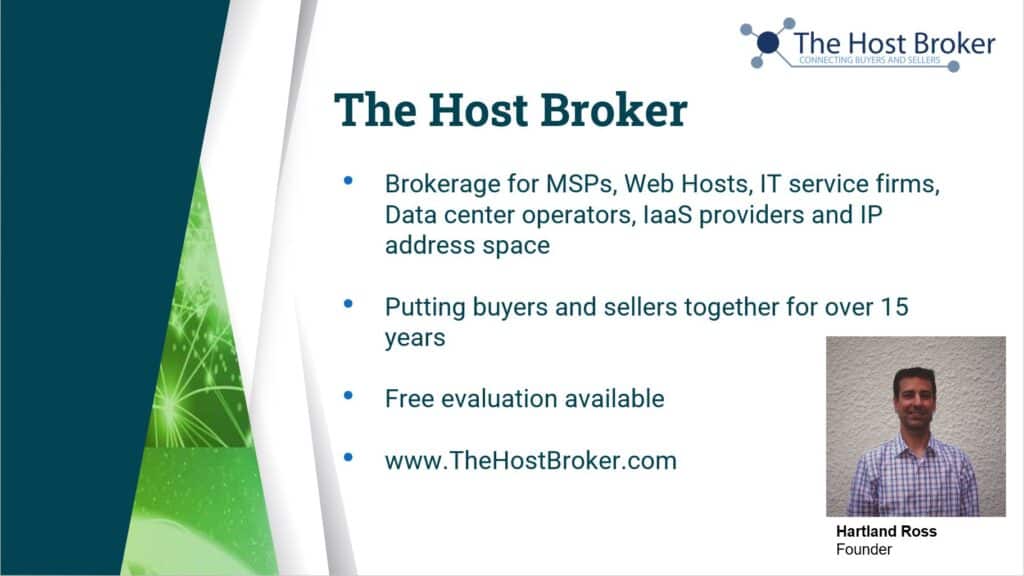
The Host Broker was founded by my boss Hartland Ross about 20 years ago and it is a brokerage for, sorry, about 15 years ago. It’s a brokerage for IT service providers including MSPs, Web Hosts, data centers, Infrastructure as a Service Providers and we also broker IP address blocks. And if you are interested in buying or selling your IT service provider, I would highly encourage you to reach out to my boss through The Host Broker website, where a free evaluation for your company is available.
eBridge Marketing Solutions
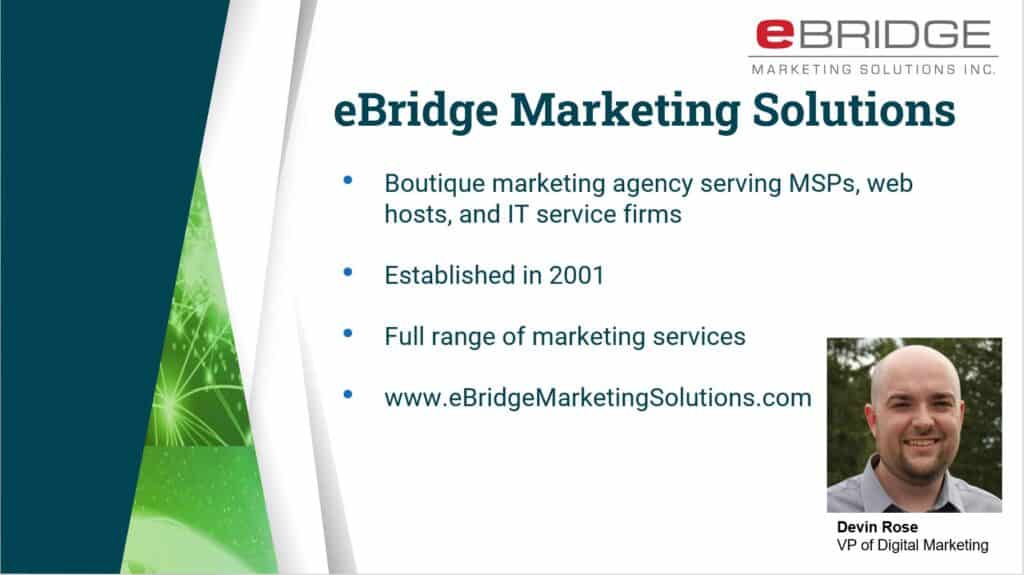
My name is Devin Rose as I mentioned and I work on the marketing side of our business which is called eBridge Marketing Solutions. We are a boutique marketing agency that serves the same space as the Host Broker. So, MSPs, Web Hosting Companies and IT service firms and we’ve been in business 20 years and we offer a full range of marketing services with a specialty in digital marketing for b2b companies. More information is available on our website and as i mentioned, I’m very pleased to be joined by our lead generation expert Colin Dowling. Colin, did you want to tell us a little bit about yourself?
Colin Dowling
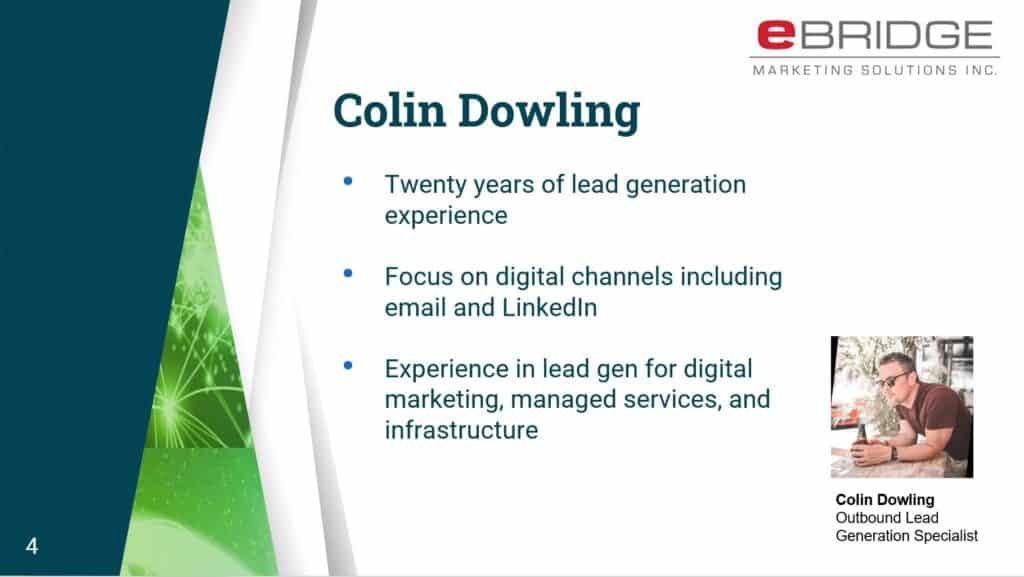
Colin: Yeah, so I’ve been in the lead generation space. Oh gosh, it’s been almost 20 years which is a little bit scary for the better part of that. At least for the last decade I’ve been primarily focusing on digital channels like email and LinkedIn and the things that actually scale well for managed service providers, hosting providers and digital agencies. My bread and butter is trying to figure out how to resonate with potential prospects, how to be relevant, how to be timely, and how to not be obtrusive. I think the hardest thing to solve when it comes to doing any sort of lead generation or outbound is to meet the buyer or the prospect where they are and not be a nuisance. And so that’s the balance that we’re always trying to achieve and that I’ve been trying to work towards that line on the horizon for the better part of 20 years.
Devin: Great. Yeah, you know I have a very similar philosophy on the marketing side, even says in my LinkedIn I’m an advocate for non-annoying marketing tactics because I think the age of the annoying people into making purchasing decisions is behind us for sure.
How Does “the Golden Rule” Apply to Outbound Lead Generation?
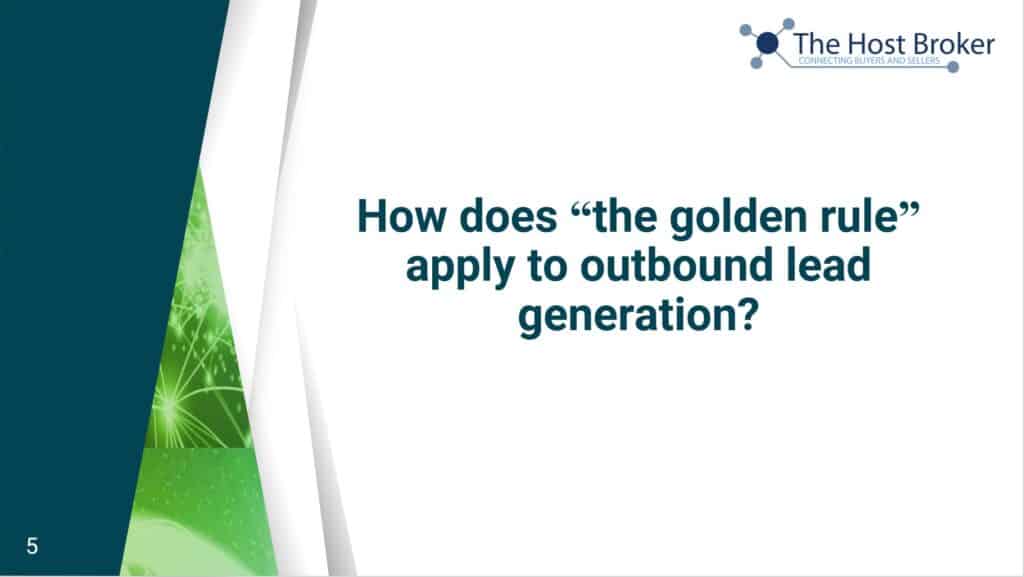
So you know today’s presentation is about outbound lead generation and Colin and I have put together a series of questions that we’re going to go through on the presentation that should really serve as some good fodder for us, to have a good in-depth conversation about outbound lead generation.
So our first question here in the slide is – how does “the golden rule” apply to outbound lead generation? And the golden rule of course being do unto others as others do unto you. I hope everyone knows that from their kindergarten classes. But before we dive into this particular question, maybe it’s just worth revisiting what is outbound lead generation, Colin?
Colin: So outbound lead generation in its simplest form is communicating with people who have never heard of you and have probably never heard of your business or the solution you offer and getting them to agree to a relationship. Now, of course, some of that’s variable. It’s possible that they’ve heard of you if you’re a large organization or organization with a great brand. But to me and this really, I think is a big part of outbound lead generation really, any lead generation is you’re not trying to eat the whole elephant at once you’re not trying to sell something on the first call or the first email exchange. You’re just simply trying to get somebody to agree to a relationship.
So when someone comes to me at eBridge and says, “Can you help me with outbound lead generation?” we want to start from the lens of saying “Yes, we can help you create relationships but outbound lead generation is a lot different than closing sales and signing deals. It’s about getting people to agree to “Hey, I’ll take your call” “Hey, I’ll answer your email”, “Yes, we can maybe work together” and that’s where we start.
Devin: That’s a great explanation. Thank you very much. How would you approach the golden golden rule as it applies to outbound lead generation? And I think the reason why we came up with this question is frankly a sentiment I get a lot when I’m talking to clients and leads. Especially in IT services, there’s a hesitancy to do marketing and lead generation sometimes because the people who work in these industries, generally speaking, don’t like being marketed to themselves. So how do you see the golden rule, kind of, apply in there and for people who don’t really like doing what we’re encouraging other people?
Colin: I absolutely love this question. I love talking with other people about the question. I’m glad we’re starting here in the webinar on this question because I don’t accept the premise that people are not interested in hearing from other people in a cold situation and let me tell you why. And obviously this is an embellished example but it’s one that’s applicable.
So Devin, even though you and I worked together, if we were total strangers if I could get into your inbox or your LinkedIn messages or even get you on the phone and say, “Devin, I’ve got a gold bar, a literal five pound gold bar with your name on it and if you’ll meet me at the corner of 1st Street and 5th Avenue, I will hand you this gold bar” and I actually did have a gold bar to hand you and we met up and I gave it to you, you would be so glad that you had opened that email and that you had responded because the value would be abundantly clear. I’ve just given you a gold bar worth tens or hundreds of thousands of dollars. The reason that people don’t like cold outreach is because the person that’s communicating with them does such a poor job of exhibiting the gold bar that they are offering, all cold outreach.
Yes, on the one hand, the person doing the reachout is trying to sell something most of the time, you know, the vast majority of the time. But when we think about sales, particularly in the B2B environment, like “I’m selling a solution to a problem that you have and let’s say, you’re an executive and you’re worried about security and i’m reaching out with a cyber security offering, it is possible that I will save you not just money but I’ll save you the chance that there’s going to be a data breach that makes your share value go through the floor, gets you fired by the board like we are offering value through cold outreach. And so the delta there, the reason that people don’t like receiving it is because people who are doing cold outreach consistently do such a poor job of explaining early what the value is that they are offering.
So circling back to the beginning of the metaphor, if every email that came into your inbox from somebody you had never heard of had a literal gold bar attached to it, if you would simply engage with them you would spend all day answering those emails but you’ve been conditioned to think that all of those emails are worthless and it’s somebody just trying to sell you something for their benefit and not solve a problem for you. And that’s why we ignore it.
And so when you think about the golden rule – treat others how you want to be treated, I approach and here at eBridge, we approach every piece of outreach with “Hey, how do we deliver that message around the gold bar to whatever problem it is that this person has? This is because everybody in every office in the world has some challenge or problem they’re trying to solve today that is simply the nature of work and by offering people solutions to those things, cold outreach can have immense immense value if we can simply find a way to connect with those folks in a way that makes them feel respected, valued, and not bothered.
Devin: Great points. I like how you rebranded the golden rule to be about the golden bar. I like that. And so what are some of the considerations in order to communicate with these people in a way that isn’t going to turn them off? Is it just the appropriate tone or striking that sort of a balance between being aggressive and being respectful and professional?
Colin: So there’s as you might imagine, a very wide range of theories and philosophies about how this works and the right answer is the one that is most effective for you and your business
and your brand. I will say that from my perspective and the way that we like to work here is to be professional, to be friendly, and to not be pushy. I love thinking about any version of sales and cold outreach as part of the sales process that any version of sales when it’s being done correctly, results in either a “yes” or “not yet” but never a “no”. And so if you’re respectful and you’re not pushy, you can typically get either a “yes” or “not yet, on your way” to having somebody start a relationship with you. The best way to do that…I think this is a pretty universal truth and a hill I would die on when it comes to cold outreach, is to be as valuable as possible as fast as possible.
So you know if you’re sending, if you find somebody who says yes I’ll have a relationship with you, “I’ll read your emails”, “sure Devin, don’t bother me too much but we can stay in touch and you start spending time building value building rapport, sending blog posts, sending case studies sending an interesting article like “Hey, you know what? I thought you’d find this interesting. You’re working in the carpet space and this is something about a new type of carpet fiber. I thought you’d find this interesting.” Build that kind of value and build that kind of rapport so far ahead of any potential sales cycle that when it comes time for that person who has agreed to the relationship with you to actually buy something, they’re not going to shop around “Oh yeah, I know Devin. Devin’s my friend, Devin has been valuable to me for weeks or months or even years. I can’t wait to give Devin my business because he’s been such a good contact along the way and so that’s the way that we should approach cold outreach.
And my last point on this is it’s very very hard in organizations particularly as they get larger and larger, for a cold outreach strategy to work well, because there’s so much focus on the numbers, so much focus on monthly or quarterly revenue and not focus on actually building relationships that can pay off over time. If you’re a small business and you have some patience, cold outreach can be unbelievably effective by evaluating things in months, quarters, or even years but if you are if you think that cold outreach is going to help you close your quota by the end of this month, you know I’ve got news for you – that’s just not going to happen.
Devin: Great. So let’s move on to the next slide here. So this question is – what are the prerequisites for a successful outbound lead generation campaign? So as an IT company, what has to be in place in order for a program like this to thrive?
What are the prerequisites for a successful outbound lead generation campaign?
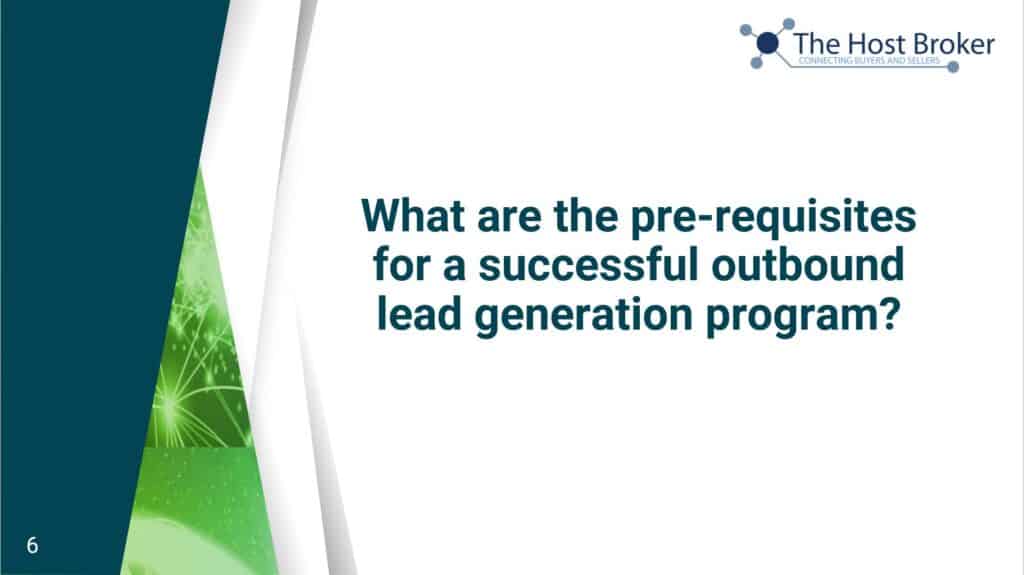
Colin: So the most important thing is good data. And that’s one of the reasons data is so expensive is because getting good data is a challenge and I’ll frame it this way. If you contact 1000 of the wrong people you will sell nothing. If you contact 10 of the right people, you might sell something. And finding the right contacts at the right companies is Step One. And there are a number of tools and I’m not going to name them, but there are a number of tools that you can utilize to find that information about who is working where and when and how. Secondly, once you have that data it is critical that you screen it or wash it a second or even third time using email verification systems, having somebody go into LinkedIn and check that the person is still employed.
There is absolutely nothing…it will be worse for your brand reputation and your email domain reputation than sending out messages to people that don’t work where you think they do or email addresses that no longer are functioning. After that, you know, the best way to accelerate success is to find a way to be relevant and find intent. One of our favorite ways to do that, for example, is to look for people that are hiring for a position. That’s the position they would hire for our service. So, for example, if I’m a managed service provider and I provide, managed cloud or brake fix, I would find companies, you know, go to a job board, find companies that are hiring a IT support desk technician and contact the CTO or the CEO or the CPO and say, “Hey, you guys are hiring to build your team along the way. We can be a partner here. We’ve got a staff that does this.” And those conversations are relevant and by looking at a thing like a job post, you’re seeing intent. Other places to find those signals are on social media LinkedIn posts where somebody expresses that they have a problem. So the better data that you have,…so that you know you’re targeting the right person and if you can find any way to connect intent and relevancy, your success with cold outreach will be significantly higher than if you just throw a bunch of darts at the phone book.
Devin: Yeah, it makes so much sense I mean I think the days of buying kind of cheap lists for a buck or two a lead from some of these big providers and just doing email marketing to them, like that doesn’t really work anymore. It really is about the quality of data as you said.
Colin: Yeah, I mean cheap lists are cheap for a reason and one of the things that we see in one of the areas of opportunity for people that do cold outbound, cold outreach is that folks understandably do want to invest in the data because they’re not sure that they’re going to be successful with what they do with it. And so, why would you spend a thousand or two thousand or five or ten thousand dollars on a list of potential prospects, even a good list, if you’re not sure what you’re going to do with it once it’s in your hands? It’s like being given the keys to a race car. It’s like “Well I’m not a race car driver. I don’t know what to do.” And so it really is a process that’s not just about the data but also about what you do with it.
One way to mitigate that risk and make sure you’re getting a good ROI is to, long ahead of doing any of this, settle in on who your ideal client is and what kind of profile your best customers have, that way you’ve narrowed in the type of data that you seek. If you have as an example, if you’re a managed service provider and you work exclusively with accounting firms in Northern California, well then you already know that it would be a waste of time to get a list of lawyers in Texas. And so the first step, pen to paper, for a good cold outreach strategy is writing down “Hey, who are our best customers? Where are we most profitable?” And then starting in that, you know, going fishing in that pond versus trying the whole ocean.
Devin: Absolutely. Alrighty. So that takes us to our next question which is kind of related in terms of the last slide – what are some of the prerequisites for success and this is what are some of the common pitfalls that you see in outbound lead generation? I suppose quality of data would probably be one. What are some others?
What are some common pitfalls in outbound lead generation?
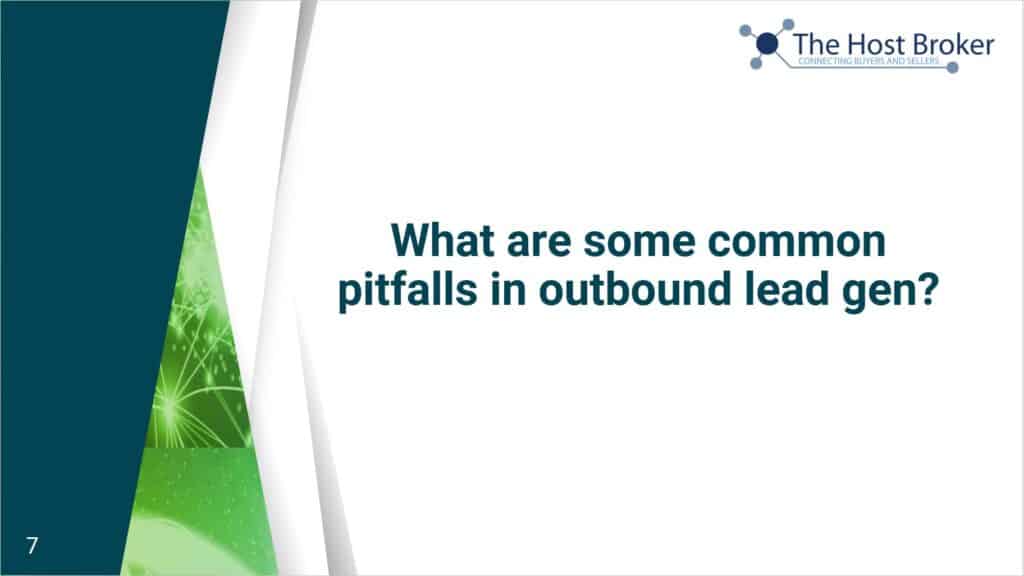
Colin: Yeah. The quality of data is a big one but from a functional standpoint, the biggest. There’s really two pitfalls of outbound that I see that that bring down outbound programs faster than anything else. One is a lack of patience on results. Cold outbound is not a standalone, it is very rarely a standalone solution that can function on its own and drive success. It is part, typically part, of a larger marketing initiative not a sales initiative a larger marketing initiative that needs to be supported by good digital assets like a website, case studies and blog posts. It needs to be supported by…even if you don’t have brand recognition, you have some brand strength, so there’s somebody opens your email and says “Oh! Who’s this person from ABC technology company?” And they go looking for you on the web that they don’t get a 500-page, that they actually find something that validates what’s in your email. So you’ve got to view cold outreaches as part of a holistic strategy and not a standalone solution to your lead generation issues.
The second thing is, you know, it takes time. We’ve got to be patient with it. If you invest in search engine optimization, I don’t know if it’s still the case but the rule of thumb used to be like it was five or six months before you should anticipate seeing results. And that’s not the same rule of thumb necessarily for cold outreach. But expecting someone to stand up a cold outreach program in three weeks and suddenly your pipeline is full in week 4 is a massive mistake. You’ve got to have some patience.
And then, finally, the thing that I think will ruin a cold outreach strategy just as fast as anything else is degrading your brand in the name of spam. It’s very tempting to say we’re going to send out 3000 messages to a thousand different contacts this week and stuff the pipeline and law of large numbers alone says that “yeah, if you do that you load up a thousand prospects on every Monday, yeah you’ll get a couple meetings out of it.” They’ll be terrible meetings, they’re not going to buy anything. And if they do, they’re not going to be good clients because they’re people that responded to spam, I mean like use your brain and so you have to be a lot more thoughtful and a lot more diligent about who you’re communicating with and why, and what problem it is you’re trying to solve versus simply mass mailing everybody whose email address you can find .
Devin: Great points. And the one that really resonated with me there is how outbound is just part of the marketing mix and it’s something I’ve encountered talking to MSPs on the marketing side too, where sometimes they look at leads as if they’re a deliverable in isolation. You just get leads. But I totally agree with you it is about being credible in terms of the rest of your marketing mix. So when someone does look you up that it all, you know, checks out and checks all the boxes and they don’t have any concerns to work with,
Colin: Yeah. You know it’s interesting, whether you’re using a third party for an outbound service or you want to do it yourself or you bring in consultants or if you’re investigating outbound, anybody that tells you it’s anything less than hard work is lying to you. There is no magic involved in outbound. It is the same shoveling of dirt that is in every other part of marketing, it is hard work but the good news is that it’s not magic. The good news is anybody can do it. I tell people often it is simple but it’s not easy, which means that there’s a pretty clear step-by-step path on having a strong outbound strategy but you’ve got to put in the hard work.
Devin: Yeah. For sure. And so in terms of that hard work, what is the role these days and without bound in terms of email outreach versus LinkedIn outreach versus cold calling? How do you see those kinds of planes?
Colin: Yeah. So the best way I can think of those three, because those three are the tent poles, is to think of it exactly as a tent. The best way to get your tent to stand up strong and weather storms and weather wind is to have all three, almost in equal measure. And if you are working on an outbound strategy or engaging a partner with an outbound strategy that is not utilizing all three of email, LinkedIn and phone then your tent isn’t quite as strong and is more susceptible to damage when things aren’t going right. And that actually fits into the greater marketing stack. The more tools you have in the tool belt the more tentpoles you have for the tent and the stronger the tent will be. If we’re gonna keep using metaphors when it comes to like which of those things works best, it’s different for every business, it’s different for every industry.
Some of that comes down to how talented your copywriters are for email and LinkedIn, comes down to how talented your callers are for phone calls. We’ve worked with companies where phone is the best channel. We’ve worked with, companies where email is the best channel and by channel I mean the starting point. What you really want to do with a cohesive and holistic outbound strategy is let the prospect know that you actually are interested and you actually care. The best way to do that is you send an email on Day 1 and 5 minutes later you make a phone call or vice versa – “Hey Dan! I was really interested in talking to you. I just sent you an email” or “Hey Dan! I’m going to send an email after this voicemail because I really want to talk to you.” You let people know that they’re not part of an automated sequence. Now you can automate a lot of this but you’ve got to make it look like they’re not part of an automated sequence. Two days later, send a LinkedIn connection. Two days after that you like their LinkedIn post and you leave a comment. Three days after that you make a phone call. A day after that you send another email.
You’ve got to come from all kinds of different sides to one, be present because some people don’t check LinkedIn, some people don’t check their email, some people don’t answer their phone. You’ve got to gotta try a bunch of different channels but by and large, our experience is that over time you want the prospect to say “Devin really wants to talk to me. He wants to talk to me today about this thing. He’s not trying to talk to 600 people even though maybe you are. Like Devin has a reason that he keeps calling and keeps emailing and keeps hitting me on LinkedIn and trying all these other ways to get into my line of sight. And that’s the sort of thing that gets the person to finally pick up the phone. Or even call you and say “Hey you know what’s cool? I agree to a relationship.” And as we talked about earlier, agreeing to a relationship is the first step on getting somebody to swim into the pipeline.
Devin: Totally. Couldn’t agree more. And so these leads that we’re generating through those different channels, how well qualified can you expect leads to be when you’re doing outbound lead generation?
Typically, how well qualified are the leads generated with outbound?
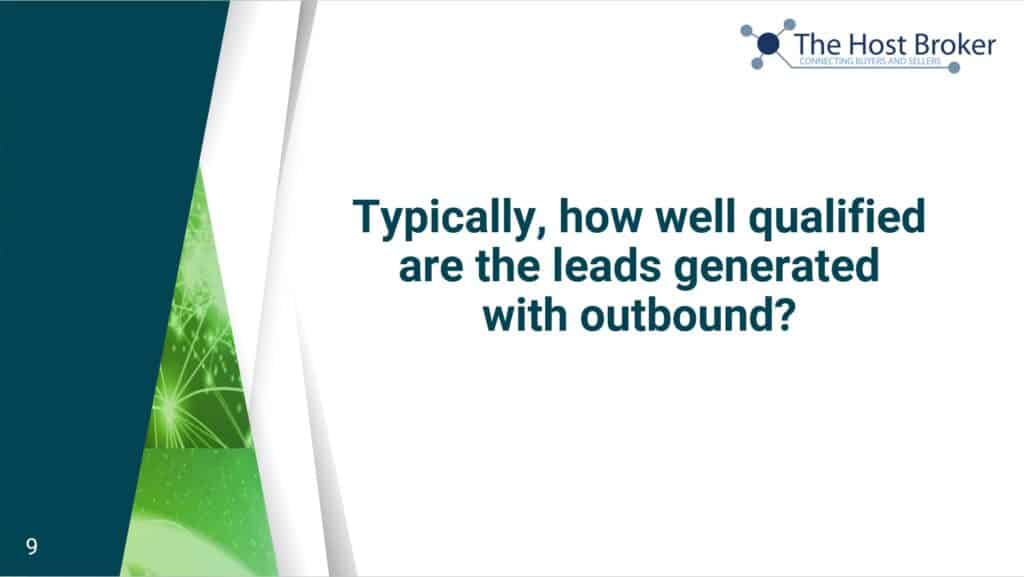
Colin: Yeah. So it’s an interesting question because like any other sort of lead or demand generation, time is typically the thing that makes things more qualified. Even somebody that meets the… or opportunity that meets the standard definition of budget, authority, need and timeline becomes stronger and stronger over time because over time they’re getting closer to a buying decision.
So, we have to enter our frame of reference that cold outbound, like anything else, is again starting a conversation. So you can participate in that buyer’s journey, be valuable in that buyer’s journey and hopefully be the thing that they choose at the end of the buyer’s journey. You know, if you think that making a cold outbound program is going to result in X leads this month and X, you know Y deals this quarter, that’s not the metric you should be looking at. What you really should be looking at is any sort of marketing that your brand is being enhanced and you’re creating relationships with people, that on a long enough timeline they will buy what it is that you have to offer. And if you do the hard work on that timeline they will buy it from you.
So the question of how qualified are these leads I would, in a short version, respond early on they’re not going to be qualified. All that much. It’s going to be pretty tenuous because you just got to know each other. It’s like meeting somebody in a casual circumstance and saying, “Do you want to go grab coffee?” The point of grabbing coffee is not to marry them. The point of grabbing coffee is to get a second date and so that’s what outbound is supposed to do, is get you the first coffee interaction and go from there. But the good news is – if you find somebody from a cold outreach standpoint, particularly somebody that’s not even in the buying window, if you continue to deliver value and you continue to build rapport over those weeks, months or even quarters or even years, as they start their buyer’s journey, again when it comes time to buy they’re not even going to think of anybody else. You’re going to be “That’s the company we want to work with, those are the people that have been in our line of sight for all this time. We’re not even taking bids, that’s who we want to work with.”
Devin: Especially if you’ve been courteous to them throughout the entire process as we discussed earlier, not being annoying and trying to add value throughout and trying to develop that relationship
Colin: 100%. One of the one of the biggest problems in sales, B2B sales, primarily in tech sales vary primarily. One of the biggest problems is that sales people continue to operate on their own timeline and not on the timeline of the prospect and I think that some of that or a lot of that comes from the Management and executives putting them on monthly and quarterly, and you know quotas. And of course quotas are important but if you’re trying to sell for your quota by the end of this month, you’re not thinking about what’s best for the prospect. Think about “Can I offer a discount and get them to sign? Can I defer payment terms and get it designed?” And if you can build up enough of these relationships that I’m talking about, and I mean enough, like dozens, hundreds. I’ve worked with hosting infrastructure companies where there have been thousands of people that a sales rep has a relationship with. When you can do it with that sort of patience, the deals just come in and the timelines don’t matter anymore because the law of large numbers says that somebody in your network of relationships is going to buy this week, this month, this quarter.
Devin: Exactly. So in these industries that we play in and I know that you have you know quite a bit of experience in these industries and also broader experience as well, but what are some of the unique aspects of marketing and doing lead generation for IT services compared to some other industries?
What are some unique aspects of marketing IT services vs. other industries?
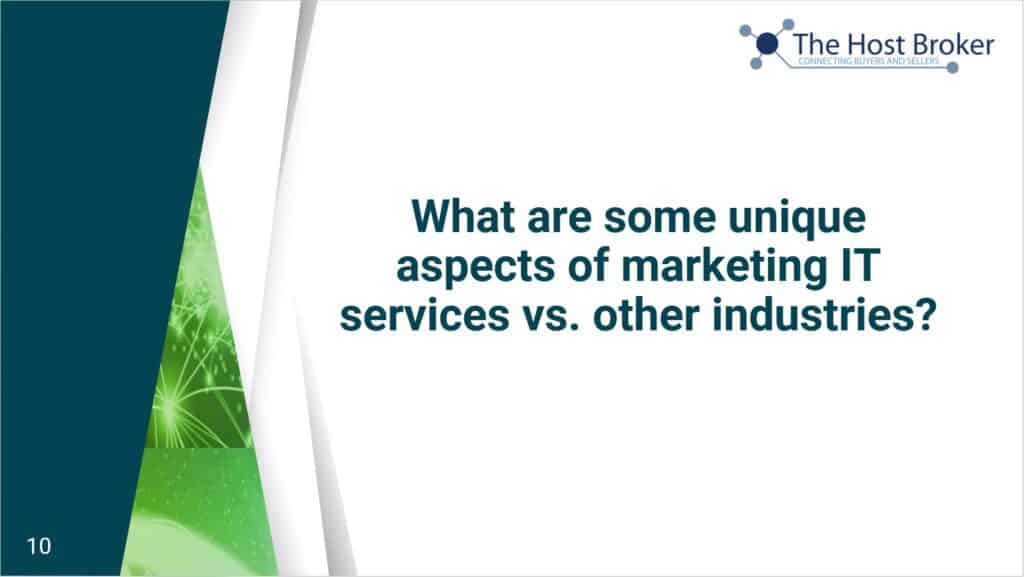
Colin: Boy, that’s a good one. You know one of the things that I think is really interesting about IT and managed services is that literally everybody you talk to ever over the age of 18 is either a potential customer or can influence a potential customer. And I say this, not necessarily as a joke, because it’s true, like undertakers have a very specific set of customers, right? Not everybody’s a customer. Maybe on a long enough timeline they are but on any given Tuesday or Thursday undertakers have a very limited set of people that could potentially buy their services. That’s just a fact.
Managed service providers, IT service providers, people that can help with with technology with digital transformation with break fix, with infrastructure, everybody over the age of 18 is either a customer or an influencer for a customer. Everybody’s got a job, everybody gets mad when the printer doesn’t work, everybody gets mad when the ERP system is down….it’s a massive inconvenience and the owner is running through the building and he’s mad because they can’t invoice customers. Like that creates demand for IT managed service providers and everybody is a potential customer. So I love the idea of cold outreach for IT and managed service providers, for that very reason as long as they’re willing to be patient, the more people that you can get to agree to have a relationship with you.
It’s really just about remaining within pointing distance until they have a problem, an IT problem. And everybody who’s watching this or listening to this knows that every company on a long enough timeline is going to get mad at their IT infrastructure. It just happens. Things go down, things get broken, they get mad, they want to blame their current it provider or the person in the office that does IT and that’s when they’re going to pick up the phone they’re going to call somebody else for a solution. And if you’re the person that’s been helpful and valuable over time, they’re going to call you. They’re going to say, “Hey Greg, our email is down. I can’t get anybody on the phone. I’m aggravated” even if they’re using office 365, right? They don’t know what’s going on. They can’t call Microsoft because that’s not the kind of support they have and like “Hey, Greg! Can you and your company show up and help us with hosting, like solve this problem” and you show up and you sell hosted exchange or transfer the licenses. And now you’ve got an end to a new customer. That’s how it works.
And and so to the original question – what are some of the big themes about doing this for managed services and IT providers, if you set up a nice outbound program as an MSP or an IT provider and you are patient and diligent, the pipeline will fill over time. It does. I’ve seen it happen. We make it happen. That’s how it works.
Devin: Yeah, like companies don’t have IOT needs these days right? You know I was having this discussion with friends the other day. We were talking about Twitter and m friends labeled Twitter as a tech company and I was kind of thinking about like “Are they a tech company?” I mean they’re a social media company. They have huge tech needs but would you consider Pizza Hut a tech company? They have huge tech needs too, it’s kind of interesting there’s not really any large companies that wouldn’t be considered to have large IT needs as well, you know? There’s no shortage of people you could put in your pipeline, I suppose is what I’m saying.
Colin: Yeah. So it makes me feel super old for you to say that because at my first sales job we actually used to fax purchase orders and invoices out on a proper fax machine. The biggest challenge yeah, DOS was the operating system for our order management rule, and the biggest challenge we would have was running out of copy toner, right? But but now you know it has moved to the center of the business. RD and software have moved to the center of the business. It’s just a fact and any company that is not embracing the idea that it is a technology company is getting stopped by a company that does technology, makes everything move faster, move more efficiently, reliably and particularly, in the last year when more and more people are working from home and businesses are truly examining their IT infrastructure.
Digital transformation is the buzz phrase of it but this has been happening for a while and so again, whether you want to talk about whether your company wants to target the Fortune 500 or you want to target mom and pop or yarn shops in your local community, everybody has IT needs.
Thank You!
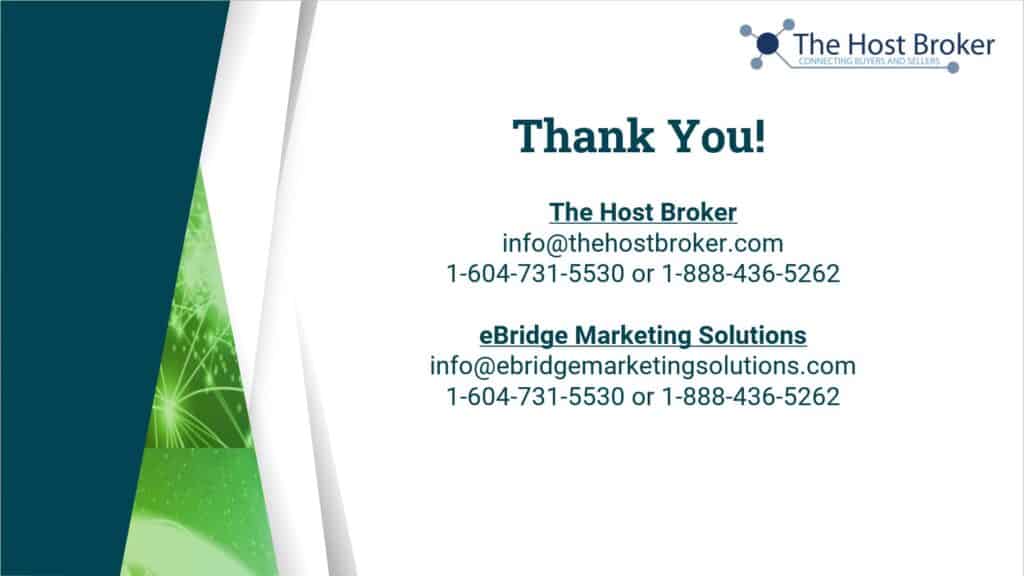
Devin: Completely agree. Well, thanks so much Colin. That was a really enjoyable conversation and I hope that our attendees here benefited from it as well, and our YouTube viewers as well. If you have any further questions for either Colin or I, you can reach out to The Host Broker and eBridge Marketing Solutions at the contact information provided there.
The Host Broker
1-604-731-5530 or 1-888-436-5262
eBridge Marketing Solutions
info@ebridgemarketingsolutions.com
1-604-731-5530 or 1-888-436-5262
Any query and I will get back to you. Colin, do you have any further thoughts here?
Colin: Yeah for sure. And I think a good outbound lead general generation program comes down to a couple of key factors that you must keep in mind. The first is that outbound is simply a part of the sales and marketing solution. It is not a silver bullet for filling the pipeline but it is a very powerful part of a holistic solution. The second thing to realize is that outbound can be extremely effective so long as you understand how to communicate with prospects and understand what your goal is. If you are trying to sell software licenses or connectivity or break fix through cold outbound, you can do that but it starts with a first step. You don’t run the whole mile all at once.
And then finally to Devin’s point, I would say if you’re interested in outbound, if you’re interested in understanding how this might fit with your business, There are a number of ways to go about it. And one of them is to engage a company, whether it’s eBridge or somebody else, like we’re not the only people that do this. Engage someone that has some expertise so that you’re already starting on third base from Day 1 instead of having to figure it all out yourself.
Devin: Perfect. Well, thanks so much Colin and thanks to everyone who joined us today. And if you have any questions please don’t hesitate to reach out. Hope you do.
Colin: Take care.
Posted September 26, 2021
Categories: Advertising and Marketing General,
Webinar
Tags: Lead Generation, outbound
